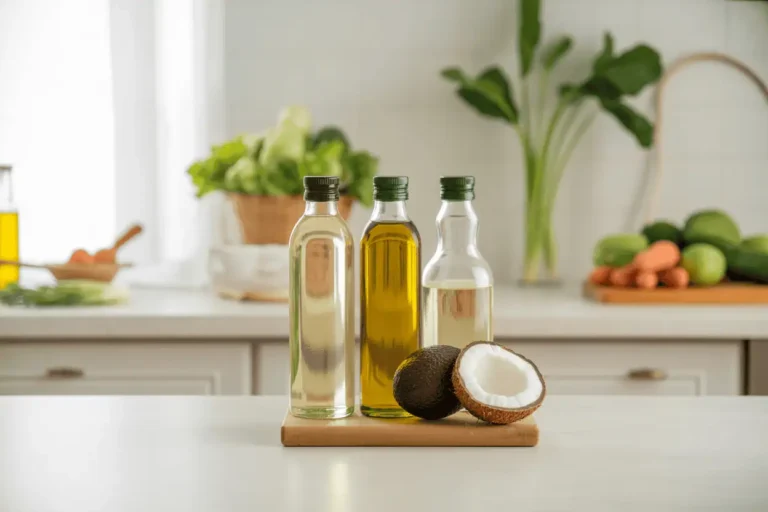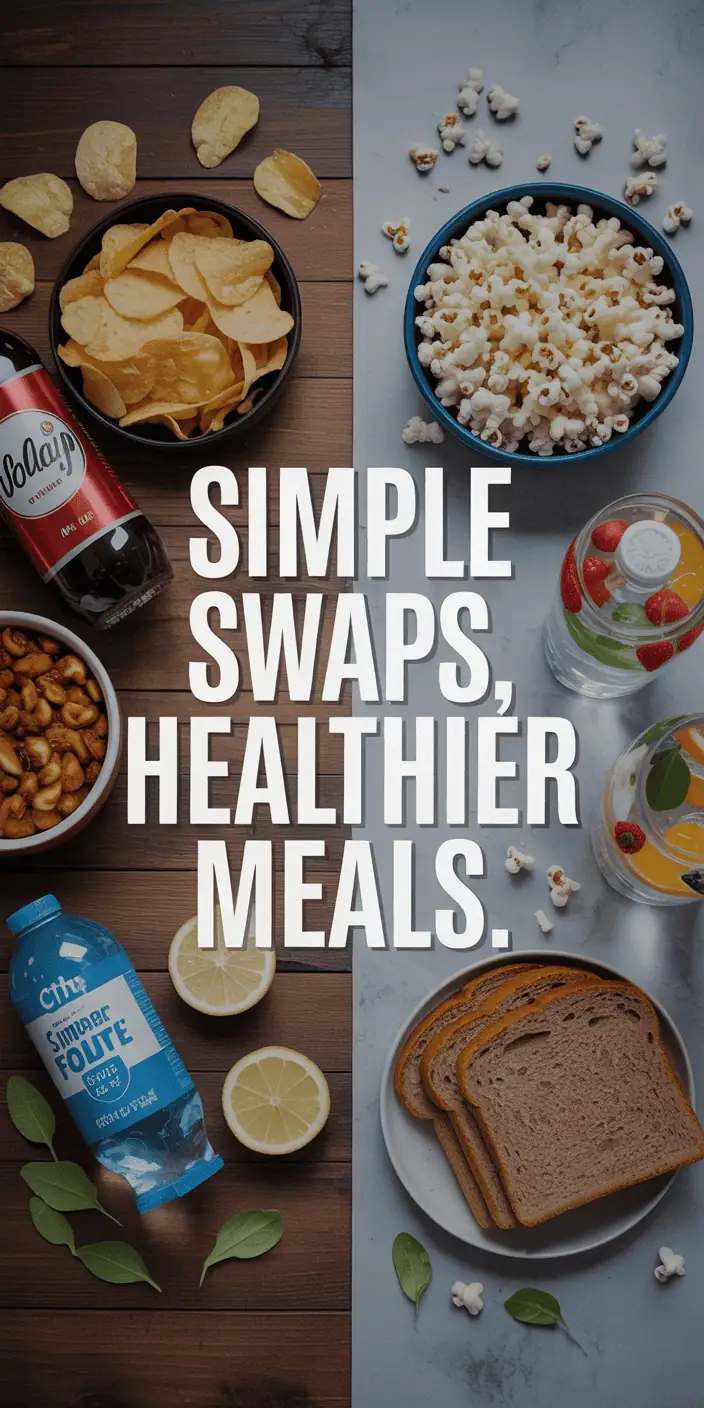Pantry Staples Every Healthy Kitchen Needs
Key Takeaway: You don’t need 47 different specialty ingredients to eat well. With just 15-20 smart pantry staples, you can create hundreds of healthy meals without constant grocery runs or breaking the bank.
Let’s be real—most of us open our pantry and see a random collection of half-empty boxes, expired cans, and that jar of something we bought for one recipe two years ago. Meanwhile, we’re ordering takeout because “there’s nothing to eat.”
The truth is, a well-stocked pantry is like having a safety net for your eating habits. It’s the difference between throwing together a nutritious meal in 15 minutes and spending $30 on delivery because you can’t figure out dinner. And the best part? You don’t need to spend a fortune or dedicate an entire weekend to organizing everything.
Why Your Pantry Is Your Secret Weapon
Think of your pantry as the foundation of your kitchen—not the flashy stuff that gets all the Instagram attention, but the reliable basics that actually keep you fed. When you’ve got the right staples on hand, you’re never more than a few ingredients away from a real meal.
The magic happens when you have:
- Grains that cook quickly and taste good
- Proteins that don’t require a trip to the store
- Flavor boosters that make everything taste intentional
- Healthy fats that satisfy and nourish
- Vegetables that won’t go bad in three days
What this actually looks like: Coming home exhausted on a Wednesday and knowing you can make pasta with white beans and whatever vegetables are in your fridge, or throwing together a grain bowl with leftover rice, canned salmon, and a quick tahini dressing.
The Cost-Benefit Reality Check
Before we dive into what to buy, let’s talk about what you’re really investing in. Because understanding the numbers helps you make smarter choices.
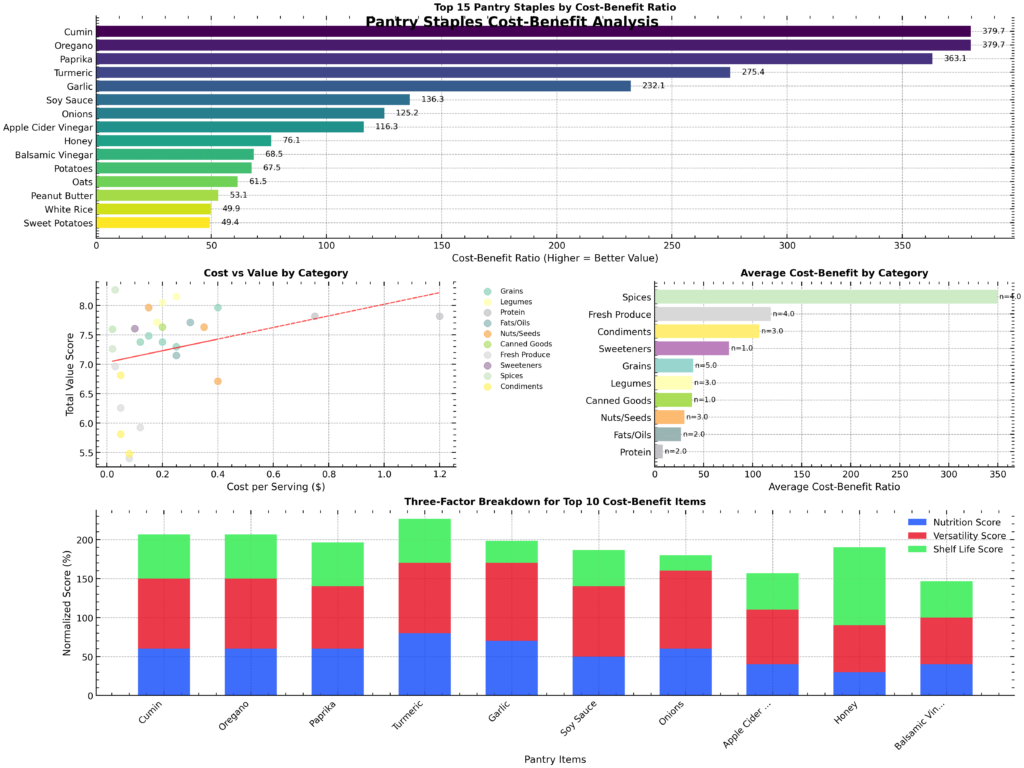
Figure: The real value of pantry staples—spices and basic aromatics give you the biggest bang for your buck, while specialty proteins cost more but offer unique benefits
Here’s what surprised me when I analyzed the numbers: Spices offer the best value by far, with an average cost-benefit ratio of 349.5 compared to just 8.5 for specialty proteins like canned salmon . That $2 container of cumin will flavor dozens of meals, while that $4 can of salmon feeds you once.

The sweet spot strategy: Focus your budget on the high-impact, low-cost items first (spices, basic grains, dried legumes), then add the pricier specialty items as your budget allows.
The Foundation Five: Your Non-Negotiable Staples
If you’re starting from scratch or working with a tight budget, these five categories will give you the most flexibility for your money.
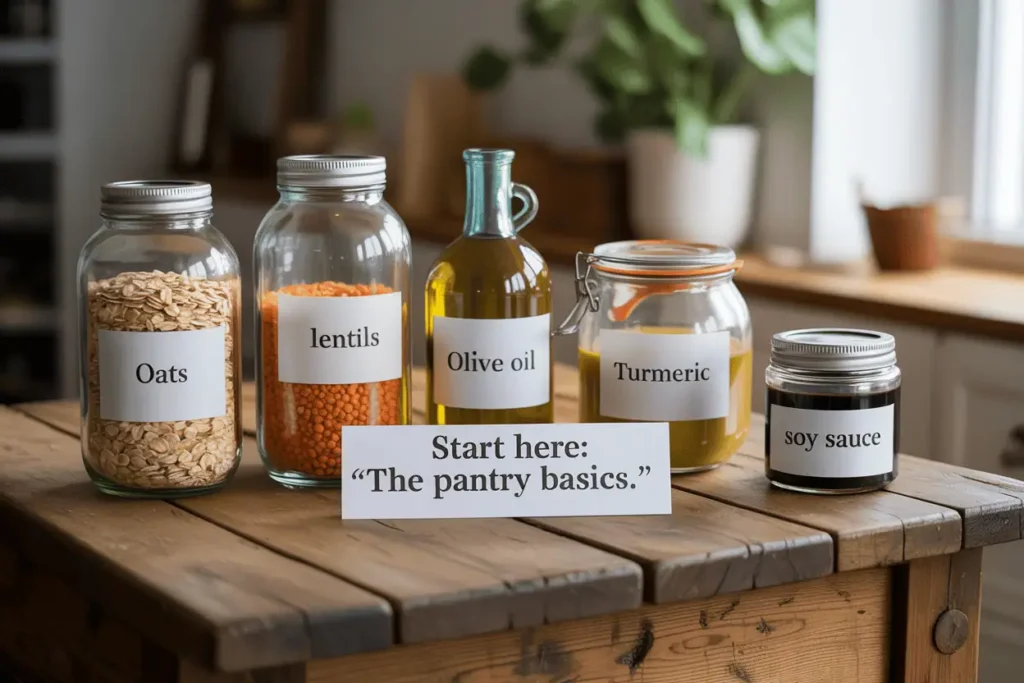
1. The Grain Game-Changer: Oats
Why oats over rice or pasta? They’re incredibly versatile, cook quickly, and work for breakfast, lunch, or dinner . Plus, at about 12 cents per serving, they’re budget-friendly.
Beyond breakfast: Savory oatmeal with sautéed vegetables and a fried egg, oat flour for pancakes (just blend oats in your blender), or as a binder for veggie burgers .
Storage tip: Keep them in an airtight container, and they’ll last over a year .
2. The Protein Powerhouse: Dried Lentils
The case for lentils: They cook faster than other dried beans (about 20 minutes), they’re packed with protein and fiber, and they work in everything from soups to salads .
Real-world uses: Red lentils break down into a creamy base for curry or pasta sauce. Green lentils hold their shape for salads and grain bowls. Brown lentils are perfect for hearty soups and stews.
Budget win: At 20 cents per serving, they’re one of the cheapest protein sources you can buy .
3. The Flavor Foundation: Olive Oil
Why olive oil wins: It’s the most versatile cooking fat you can own. Use it for sautéing, roasting, salad dressings, and finishing dishes .
Quality matters, but not how you think: You don’t need the $25 bottle for cooking. A mid-range extra virgin olive oil (around $8-10) works great for most uses. Save the fancy stuff for drizzling.
Storage reality: Keep it in a cool, dark place, and use it within a year of opening .
4. The Spice That Changes Everything: Turmeric
Beyond the health hype: Yes, turmeric has anti-inflammatory properties, but more importantly, it adds warmth and depth to almost any savory dish .
How to use it: Add a pinch to rice while it cooks, mix it into scrambled eggs, or use it in curry-spiced roasted vegetables.
The spice strategy: Start with turmeric, cumin, paprika, and oregano. These four spices can create flavor profiles for Mediterranean, Indian, Mexican, and Middle Eastern dishes.
5. The Umami Booster: Soy Sauce
Why soy sauce is essential: It adds depth and saltiness to everything, not just Asian dishes . A splash in pasta sauce, salad dressing, or even roasted vegetables makes everything taste more intentional.
Storage bonus: It lasts practically forever in your pantry and costs about 5 cents per serving .
The Complete Pantry Staples List (By Category)
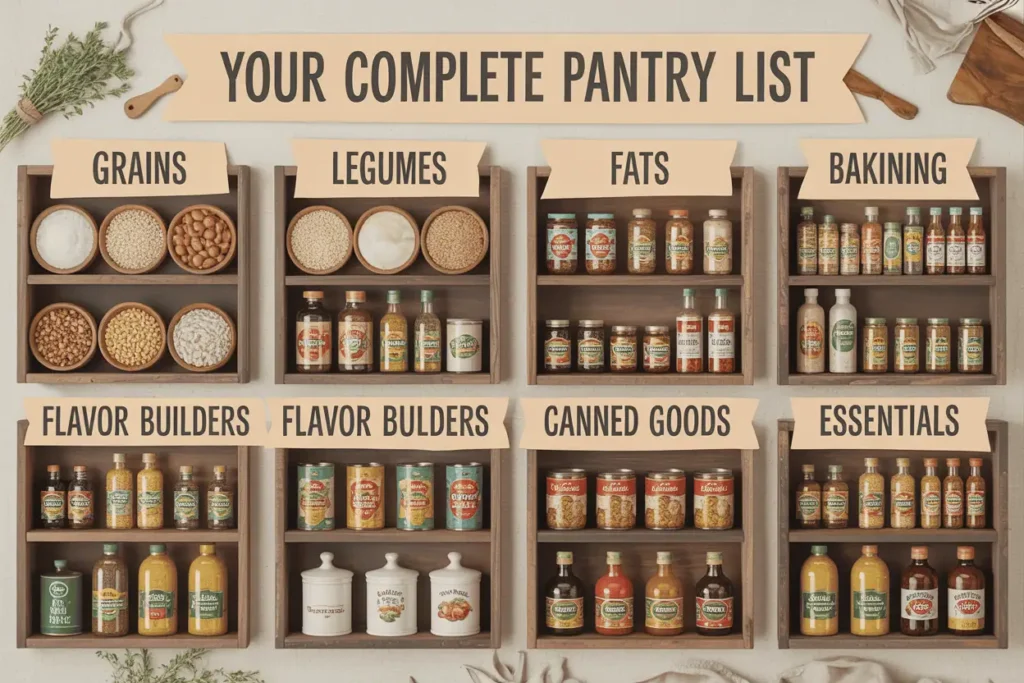
Grains & Starches
- White or brown rice: The ultimate base for any meal
- Quinoa: Complete protein, cooks in 15 minutes
- Whole grain pasta: For quick weeknight dinners
- Oats: Breakfast, baking, and savory applications
Storage tip: Keep grains in airtight containers to prevent pests. White rice lasts 2+ years, brown rice about 6-12 months .
Legumes & Plant Proteins
- Dried lentils (red and green): Fast-cooking, versatile
- Canned chickpeas: Instant protein for salads and pasta
- Dried black beans: For Mexican-inspired dishes
- Canned tuna or salmon: Omega-3s and convenience
Money-saving hack: Dried beans cost about half as much as canned, but canned beans save you time. Keep both on hand .
Healthy Fats
- Extra virgin olive oil: For cooking and dressings
- Coconut oil: Great for baking and high-heat cooking
- Nuts and seeds: Almonds, walnuts, sunflower seeds for snacking and salads
- Nut butters: Peanut, almond, or tahini for sauces and snacks
Flavor Builders
- Essential spices: Cumin, turmeric, paprika, oregano, garlic powder
- Vinegars: Apple cider and balsamic for dressings and marinades
- Condiments: Soy sauce, hot sauce, mustard
- Aromatics: Onions and garlic (they last weeks when stored properly)
Canned Goods
- Canned tomatoes: The base for countless sauces and soups
- Coconut milk: For curries and creamy sauces
- Broth: Vegetable or chicken for soups and cooking grains
- Canned fish: Tuna, salmon, or sardines for quick protein
Sweet & Baking Essentials
- Honey or maple syrup: Natural sweeteners that last forever
- Vanilla extract: For baking and even some savory dishes
- Baking soda and powder: For quick breads and pancakes
- Flour: All-purpose for basic baking needs
Creative Ways to Use Your Staples
The real magic happens when you start combining these basics in unexpected ways. Here are some combinations that work better than you’d think:
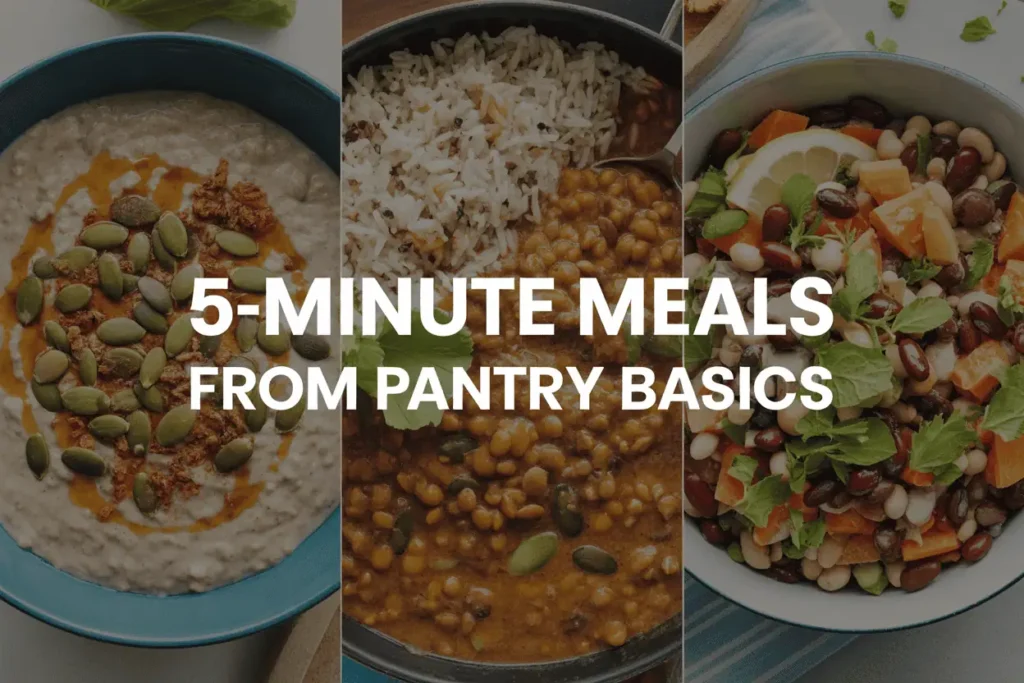
The 5-Minute Meals
Chickpea “tuna” salad: Mash canned chickpeas with tahini, lemon juice, and whatever vegetables you have. Eat with crackers or in a wrap .
Savory oatmeal bowl: Cook oats in broth instead of water, top with a fried egg and sautéed vegetables .
Emergency pasta: Pasta + canned tomatoes + garlic + olive oil + whatever herbs you have = dinner in 15 minutes .
The Batch-Cooking Winners
Lentil curry base: Cook red lentils with coconut milk, turmeric, and cumin. Add different vegetables throughout the week for variety .
Grain bowl foundation: Cook a big batch of quinoa or rice on Sunday, then top with different combinations of beans, vegetables, and dressings all week .
Versatile bean salad: Mix any canned beans with olive oil, vinegar, and herbs. It gets better as it sits and works as a side dish or protein addition .
The Flavor Transformation Tricks
Spice blends: Mix cumin + paprika + oregano for Mexican flavors, or turmeric + cumin + garlic powder for Indian-inspired dishes .
Quick pickles: Slice any vegetable, cover with vinegar and a pinch of salt. Ready in 30 minutes and lasts for weeks .
Nut butter sauces: Thin any nut butter with soy sauce, vinegar, and a touch of honey for an instant sauce for noodles or vegetables .
Storage Strategies That Actually Work

The Container System
Invest in airtight containers: They keep food fresh longer and prevent pests. Glass jars work great and let you see what you have .
Label everything: Include the date you opened or transferred items. Use the “first in, first out” rule to minimize waste .
Size matters: Use smaller containers for spices and larger ones for grains. This prevents you from buying huge quantities of things you rarely use.
The Shelf Life Reality Check
| Item | Pantry Life | Storage Tip |
|---|---|---|
| White rice | 2+ years | Airtight container, cool place |
| Dried beans | 1+ years | Check for bugs before storing |
| Spices | 2-4 years | Away from heat and light |
| Canned goods | 1-2 years | Check for dents or rust |
| Oils | 1 year unopened | Cool, dark place; 6 months after opening |
| Nuts | 6-12 months | Refrigerate for longer life |
The Fresh Produce Strategy
Long-lasting vegetables: Onions, garlic, potatoes, and carrots can last weeks when stored properly .
Storage locations matter: Onions and potatoes should be stored separately (they make each other spoil faster), and garlic does best in a cool, dry place with good air circulation .
Budget-Smart Shopping Strategies
The Bulk Buying Rules
Buy in bulk for: Rice, oats, dried beans, and spices (if you use them regularly) .
Don’t bulk buy: Nuts (they go rancid), oils (they have limited shelf life), or anything you’ve never tried before.
The math that matters: Buying a 5-pound bag of rice costs about $3 and provides 50+ servings. That’s 6 cents per serving compared to 25 cents for individual packets .
The Sales Strategy
Stock up during sales: Canned goods, pasta, and other non-perishables when they’re 30% off or more .
Seasonal timing: Buy canned tomatoes in late summer when fresh tomatoes are abundant and prices drop .
Store brands work: For basics like rice, beans, and canned tomatoes, store brands are often identical to name brands at 20-30% less cost .
The Priority System
Tier 1 (Buy first): Spices, onions, garlic, rice, dried lentils, olive oil Tier 2 (Add next): Canned tomatoes, pasta, oats, canned beans Tier 3 (Nice to have): Specialty oils, nuts, canned fish, coconut milk
Start small: You don’t need everything at once. Build your pantry over 2-3 shopping trips to spread out the cost.
Troubleshooting Common Pantry Problems
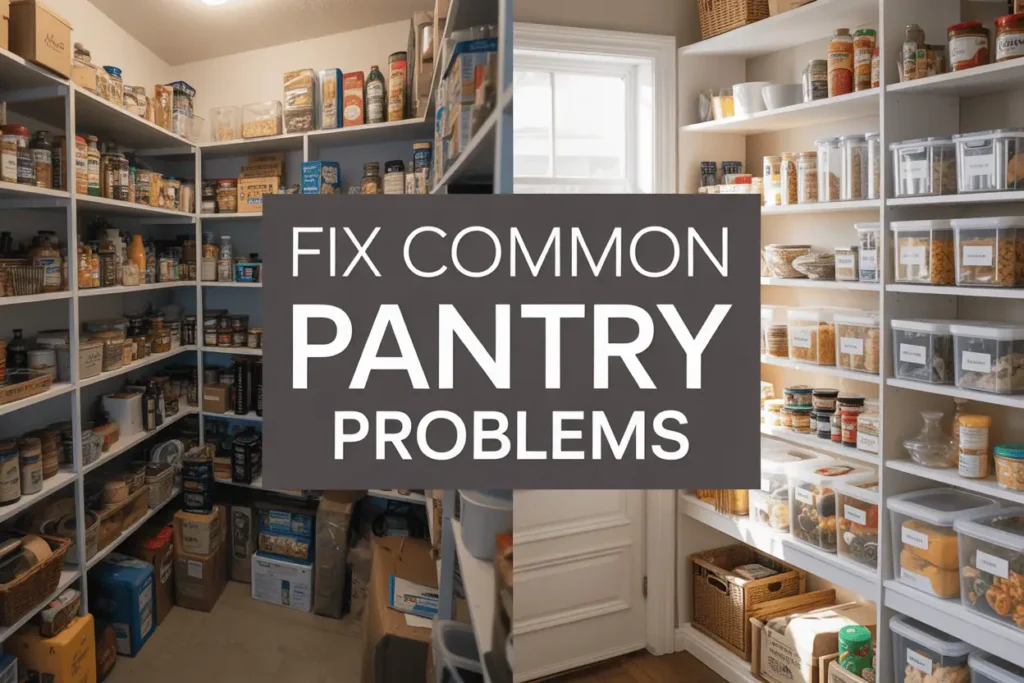
“Everything goes bad before I use it”
The fix: Start with smaller quantities and focus on versatile ingredients. A small container of cumin that you use regularly is better than a large one that sits for years.
Reality check: It’s better to buy a $1 can of beans and actually eat it than a $3 bag of dried beans that sits in your pantry for months.
“I don’t know how to use half this stuff”
The fix: Pick one new ingredient per week and find three ways to use it. This week, try tahini in salad dressing, as a sauce for vegetables, and mixed into oatmeal.
The learning curve: Start with familiar flavors and gradually expand. If you love Italian food, master olive oil, garlic, and herbs before moving on to Asian or Indian spices.
“My pantry is a disorganized mess”
The fix: Group similar items together (all grains in one area, all spices in another) and use clear containers so you can see what you have .
The 15-minute rule: Spend 15 minutes once a month reorganizing and checking expiration dates. It’s much easier than a complete overhaul.
Making It Work for Your Real Life
If You’re a Complete Beginner
Start here: Rice, canned beans, olive oil, onions, garlic, and one spice blend you like.
Your first week: Make rice and bean bowls with different vegetables and seasonings. You’ll be surprised how satisfying and varied they can be.
If You’re Budget-Conscious
Focus on: Dried beans and lentils, rice, oats, basic spices, and seasonal vegetables.
Skip for now: Specialty oils, expensive nuts, and canned fish. Build your foundation first.
If You’re Short on Time
Prioritize: Canned beans, quick-cooking grains like quinoa, pre-made sauces, and frozen vegetables.
Time-saving hack: Spend 20 minutes on Sunday cooking a big batch of grains and chopping vegetables. It’ll save you hours during the week.
If You Love to Cook
Expand with: Specialty vinegars, different types of salt, unique spices, and high-quality oils.
The fun part: Once you have the basics down, you can experiment with ingredients from different cuisines without worrying about waste.
The Real-World Test
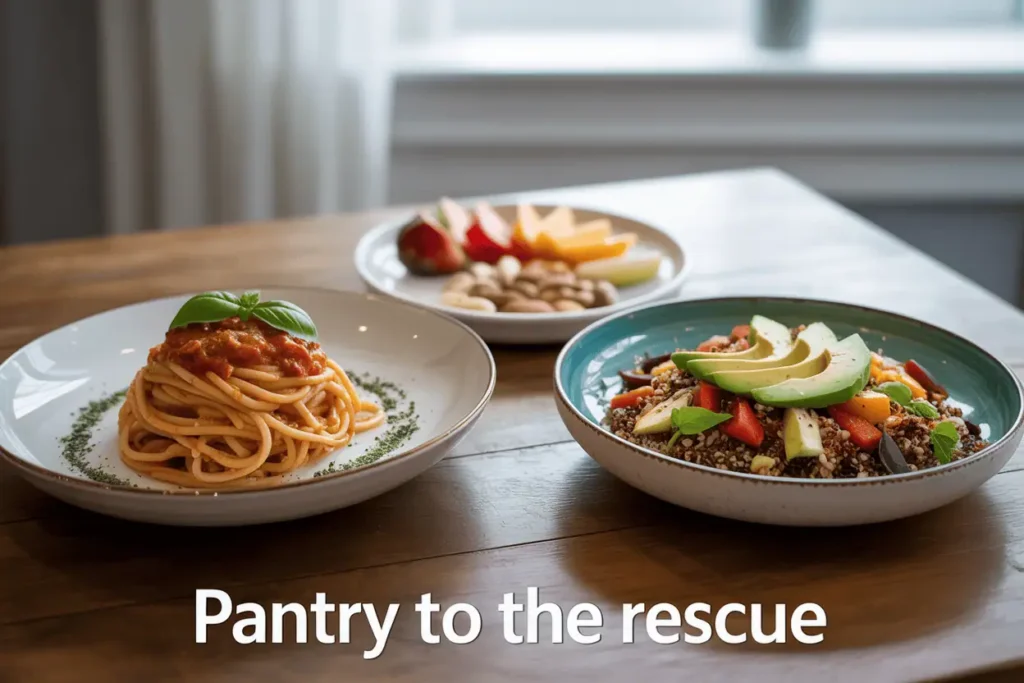
Here’s how you know your pantry is working: you can walk into your kitchen on any given weeknight and make a satisfying meal without a grocery run. It doesn’t have to be Instagram-worthy—it just has to taste good and make you feel fed.
The scenarios that matter:
- Sunday night: You’re tired and haven’t planned anything, but you can make pasta with whatever vegetables are in your fridge
- Wednesday emergency: Unexpected guests, but you can throw together a grain bowl or quick soup
- Friday laziness: You don’t want to cook much, but you can make a satisfying snack plate with crackers, nut butter, and fruit
What success looks like: Less food waste, fewer emergency takeout orders, and the quiet confidence that comes from knowing you can always figure out a meal.
The Bottom Line
A well-stocked pantry isn’t about having every possible ingredient—it’s about having the right ingredients that work hard for you. The ones that show up in multiple cuisines, store well, and don’t break the bank.
Start with the Foundation Five: oats, lentils, olive oil, turmeric, and soy sauce. These five ingredients alone can create dozens of different meals.
Build gradually: Add one or two new staples each shopping trip. Focus on items you’ll actually use, not things that sound impressive.
Remember the goal: Your pantry should make eating well easier, not more complicated. If you’re spending more time organizing than cooking, you’re probably overthinking it.
Your new mantra: “Good enough is perfect.” A pantry stocked with basics you actually use beats a Pinterest-perfect setup that intimidates you into ordering pizza.
The best pantry is the one that gets you cooking more meals at home. Start simple, build slowly, and trust that even basic ingredients can create meals that taste intentional and satisfying. You’ve got this—and your future self will thank you every time you open those cabinet doors and see possibility instead of chaos.


